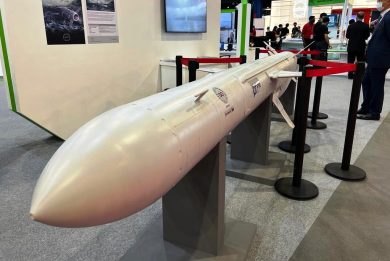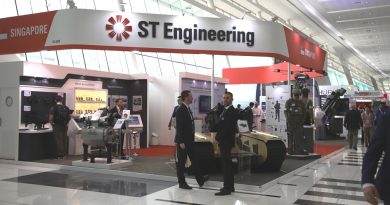
Singapore Airshow – ST Engineering unveils its Terrex s5, the next gen Singaporean 8×8
At the 2024 edition of the Singapore Airshow ST Engineering, the Singaporean defence industry champion, unveiled the Terrex s5, latest iteration of its 8×8 armoured platform, which aims at improving performances not only in the operational field but also enhanced intelligence
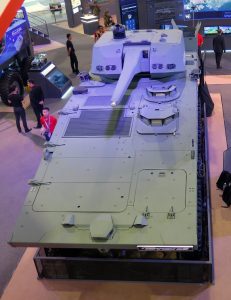
Born primarily to provide a showcase for the aviation industry, the Singapore Airshow has evolved to include also other defence related equipment and technologies. It is therefore not a surprise that ST Engineering is unveiling its new products at the event, the main one this year being the Terrex s5 8×8 Infantry Fighting Vehicle. The name “s5” represents the five capabilities of the new vehicle, Smartness, Superiority, Sustainability, Survivability and Serviceability, in which the company has inserted advanced technology. This obviously includes the full spectrum of new electronic capabilities, so even before starting let us say that the Terrex S5 leverages the knowledge of ST Engineering cybersecurity business unit to ensure maximum protection against cyber-attacks.
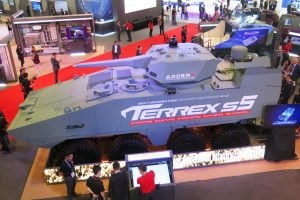
The electronic architecture is designed to fully exploit new technologies, bringing as much intelligence as possible into the vehicle. The driver and commander sit side by side and are no more separated, and have in front of them three large colour displays, a main one at the centre and two smaller on the sides slightly angled; man-machine-interface is provided by three consoles, one in the middle and one on each side, and two gaming-style commands for driving, which allow to switch driving responsibility between the two front crew members. Screens provide a see-through armour capability. The vehicle is equipped with enhanced image processing to provide a stereoscopic effect giving the crew a sense of depth, which makes viewing more realistic, and represents a considerable help especially for driving. From the vehicle deck the two operators can set the planned course through waypoint driving, a solution that considerably reduces the driver workload, control unmanned air and ground assets (a multirole UGV with pan-tilt-zoom camera is pictured in the brochure beside the fighting vehicle version) operating in cooperation with the vehicle and conduct the mission exploiting the automatic target detection and tracking system, also developed by the company. This introduced machine intelligence algorithms, further developments being planned to follow the constant improvements in this field. Of course, computing power was key to all this, ST Engineering exploiting edge computing to cope with the needs of all those functions, the one most power computing hungry being quite probably image processing. EDR On-Line understood that realistic imaging is not limited to the frontal arc but covers all 360° around the vehicle.
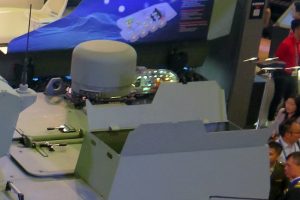
High-end imaging processing also ensures an obstacle detection capacity, coupled with low light image enhancement, as well as a bird’s-eye view providing bearing and range of objects located around the vehicle, all this increasing survivability ad improving operational efficiency. This is obtained thanks to a tethered UAS, hosted in a box on the left rear side of the roof, which supplements the 360° prismatic camera system developed by ST Engineering itself.
All this needs a considerable on-board electric power, the Terrex s5 being fitted with a 910 A alternator, Li-Ion batteries being available on board providing more than 12kWh . A smart power management system ensures optimal distribution and prioritisation. The Terrex s5 gross vehicle weight is 35,000 kg, of which 13,000 kg represent the payload. The vehicle is 8.3 metres long, 3 metres wide and 2.7 metres high, at the hull ceiling. The considerable payload allows to consider fire support variants with a turret armed with at least a 105 mm rifled gun, possibly a 120 mm smoothbore one, other variants being Infantry Fighting Vehicle, Command Post, Antitank Missile Carrier and Mortar Carrier. ST Engineering also proposes an amphibious version of its Terrex s5. In that case GVW will be limited to 32,000 kg, the company considering a turret armed with a 30×173 mm cannon the maximum firepower installable.
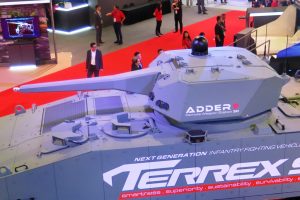
In the IFV configuration seen at the Singapore Airshow the vehicle carries 10 dismounts in the rear compartment, seated in two rows of five facing each other. The vehicle is fitted with the Adder Remotw Weapon Station 30 armed with a 30×173 mm cannon with coaxial 7.62 mm machine gun, with respectively 250 and 500 ready rounds. Fully stabilised, it is fitted with auto-surveillance, auto target detection and tracking, target classification, touch screen target designation and video tracking. Maximum elevation is +60°, well suited for operating in urban canyons, while depression is -20°. Combat weight is less than 2,000 kg, which leaves a further 11 tonnes payload for the standard vehicle and 9 tonnes for the amphibious version. Part of this can be used to upgrade turret protection to Level 4 according to STANAG 4569. The turret can also integrate antitank guided missiles, as well as counter-UAS sensors. Protection provided by the vehicle to its occupants is Level 4 ballistic and Level 4 a/b against blast; improvements were made on the V-hull compared to the Terrex s3, the considerable payload allowing further increases in protection levels according to customer’s choice. The new vehicle is designed to accept an active protection system.
The Terrex s5 is powered by a turbo diesel engine providing 711 hp coupled to an automatic gearbox with seven forward and two reverse gears. It is fitted with independent suspensions that can be upgraded to become height adjustable, and even become active suspensions. The vehicle on show is equipped with 16R20 tires, 14R20 being proposed as option, fitted with runflat inserts, the Terrex s5 featuring a central tire inflation system. The new vehicle is fitted with hydraulic power steering; as standard the front axle is steerable, the customer being able to require the stterable rear axle as option. Respective turning radius are less than 10 and 8.5 metres. The Terrex s5 is fitted with a pneumatic braking system with ABS. providing good capacity when the 35 tonnes vehicle must be stopped, considering its maximum speed on road of 120 km/h, road range being 1,000 km at cruise speed.
Mobility data are pretty similar to the predecessors, with 40° approach and departure angles, thanks to limited overhand front and rear, maximum gradient being 60% and side slope 30%, with maximum vertical obstacle of 0.7 metres, trench crossing capacity of 2.0 metres and fording depth of 1.8 metres for the non-amphibious version.
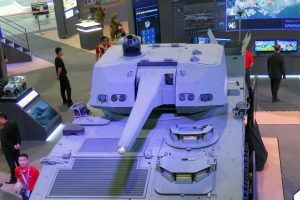
An “s” that must not be forgotten is Serviceability; to reduce the logistic burden the Terrex s5 is fitted with on-board diagnostics, health and usage monitoring system sensors, providing condition-based maintenance data, and with smart maintainability features that improve users’ operational experience.
The vehicle exhibited at the Singapore Airshow will undergo a series of trials overseas. As for manufacturing, the company leveraged the work and know-how from the production of the Hunter armoured fighting vehicle, optimising the Terrex s5 design to maximise robotised operations in order to decrease production costs and increase accuracy.
Under the sustainability “S” ST Engineering states that the Terrex s5 is “hybrid electric drive ready”. The company has already been working for several years on diesel-electric hybrid propulsion, initially on the Next Generation Light Strike Vehicle and then on the Next Generation Protected Vehicle (NGPV). EDR On-Line understood that the R&D department is developing a hybrid solution in parallel with the Terrex s5 development. The selected solution is a serial-hybrid, that will start using e-axles. So far, the tests with the 20 tonnes NGPV provided good results, the axles needed for the latest version of the Terrex being pretty similar, considering the single axle load. However, ST Engineering developers are looking with interest at a hub-drive solution, as this would considerably increase the freedom of design, getting rid of many mechanical elements that have a negative effect on maintenance and protection, especially against underbelly blast events.
Photos courtesy J. Roukoz

